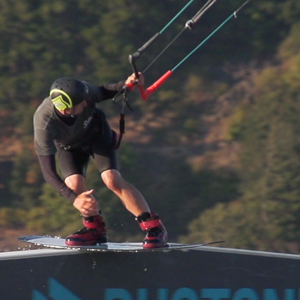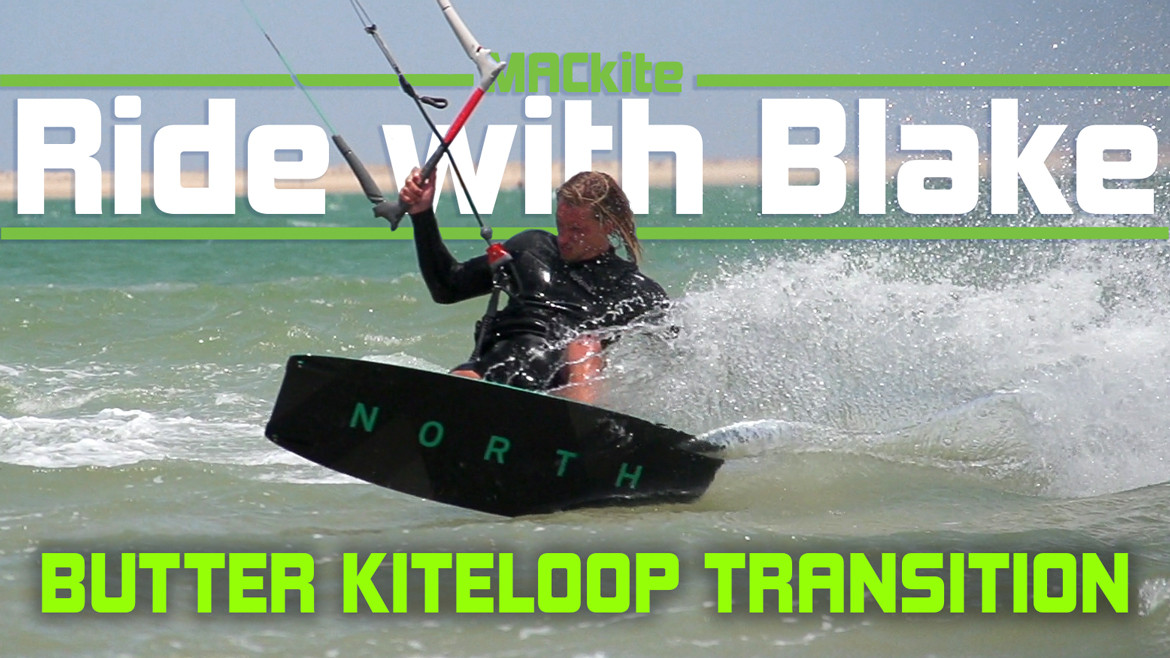Butterslide Kiteloop Transition
Today we are going to go over how to do a toeside butterslide kiteloop transition. This trick is a fun and easy one that doesn’t take much risk. A butter slide is when you weight the back of your board as you ride through the water. It’s done by hopping off of your heelside edge, spinning to toeside and weighing the nose of your board. This works best in flat water so that you can hold a steady edge. It’s natural to spin this around into toeside and then you are ready to make a carving transition.
The prerequisites for this are riding toeside, understanding kiteloops and knowing how to do a butter slide. We recommend having these basics down as you will need the body awareness that comes from practicing them to pull this one off. It's actually not a difficult trick but it does require the rider to twist their body and redirect the kite with a kiteloop.
PDF Available soon

Step 1: Pop and twist
As you go into the trick, build up speed to carry you through the slide. Once you are ready, pop and twist like you would if you were to pop toeside. Keep your weight centered over the board until your touching down to the water. As you come down lean back and get your weight centered over the new back knee, all the while pulling up on your front foot. This will get you into the butterslide. We also have a video on how to butter slide if you’d like to check that out.
As you pop and twist open up your shoulders by taking your front hand off of the bar. This will help you balance the weight of the back foot for your butter slide and drag your hand through the water.

Step 2: Butterslide
The butter slide is the fun part of this trick, you can spray water and tweak your board for a fun, surf style transition. The key to the butterslide is to not kill all of the power on the landing. Once you’ve popped and twisted, you want to angle your board slightly downwind to the direction you are traveling.
Think of this as a powered toeside butterslide with all of your weight over your back foot. Don’t point the board straight in the direction you want to go, the force of the board against the water will stop your momentum and you’ll sink into the water with the kite going to the edge of the window. You should angle the board slightly downwind and it will ride like a fin through the water allowing you to continue sliding for longer. This is much easier to do in stronger winds but try it out in light winds and mess around with the timing of it all. You can do a long butter slide into a sliding transition, or do a quick one and make a fast transition. If you are going for the long butter slide it’s easiest if you have flat water, where the quick butter slide is great for in the waves.

Step 3: Transition with kite
During the butter slide you want the kite to be pulling you forward in the direction that you are traveling so keep it low until you're ready to go. Once you’ve had enough butter sliding and are ready to transition, send the kite past the zenith and weight your front foot. This will make you pivot into riding toeside and it’s time to carve into your turn.

Step 4: Carve and slide
Now your all set up with the transition, you’ve popped, twisted, dropped your hand, transitioned with the kite and it’s time to carve and slide in the other direction. This comes quite naturally and I would recommend doing this in the direction you are comfortable spinning to toeside in.
After the carve you can slide out like you would if you were slashing the top of a wave. You’re going to slide as you transition from toeside to heelside so make sure to transfer your weight from your old back knee to the other side. It’s a nice addition to throw in there and is easy when the kite is transitioning to the other direction. You can hold your slide until the kite reaches the side of the wind window. Once it’s at the edge, this is where you add the kite loop.

Step 5: Kite loop transition
The key to not falling on the kiteloop is to make sure to point your board straight downwind as you loop the kite. If you hold an edge against the kite loop it can do a number of things that will send you flying into the water. Pull in on the bar and your back hand looping the kite to pull you out of your slide. The reason you want to loop it rather than transition the kite across the window is because the loop will pull you up so that you can get really laid out and drag your hand across the water. If you simply send it across it might night be enough to get you back up.
Well that’s it, hope you guys have fun out there and enjoy this new trick!
Need help on these tricks?
Follow the guys on their adventures and shoot us a message.
 Blake Olsen
Blake Olsen
A Michigan boy through and through (even though he was born in Saudi Arabia), Blake is a youth with a lifetime of experiences and adventures. Not only that, he's passionate about sharing his zest for life with others. He is proficient at many fields, including kiteboarding and acting as concierge to any who simply ask. Looking for an adventure? Well, Blake is your guy. From sailing the Gulf and the Caribbean to backpacking Hawaii and Southeast Asia, he knows his stuff and can make your vacation into an adventure.
Webpage: BlakeTheOlsen.com
Instagram: @BlakeTheOlsen
 Ryan (Rygo) Goloversic
Ryan (Rygo) Goloversic
Many people dream of quitting their job, traveling the world and pursuing their passions. Rygo is one of those people who pulled the trigger. A few years into his career, he decided to change everything and travel as a kiteboarder, freelance videographer & writer. His mission is to share the stoke & help people put the boarding into their kiteboarding. Get outside and kite!
Producer of: Ride with Blake I Sessions I Versus I Destinations I Foil Fridays
Recent Posts
-
Foil Drive | Essential Maintenance Tips to Help Enjoy Your Ride
Ryan from MACkite takes a few minutes to chat with Ben from Foil Drive and pick up some ti …22nd Apr 2024 -
North Navigator Pro Quick Release | How to Swap Yours Out With Ease
What You Need Before starting the replacement process, ensure you have all the necessary t …18th Apr 2024 -
Foil Drive | Essential Tips to Supercharge Your First Session
The Foil Drive makes your foiling life easier. You'll get up easier and catch more waves, …17th Apr 2024





